
SECTION 5 - MAST COMPONENTS
5-12
31215825
Cylinder Disassembly
(See Figure 5-11.)
1.
Before disassembling the cylinder, clean away all dirt
and foreign substances from openings, particularly the
head area.
NOTE:
Always protect the chrome surface of the cylinder rod
during assembly and disassembly. Any damage to this sur
-
face will require replacement of the rod.
2.
Extend the rod until the piston bottoms out against the
cylinder head.
3.
Compress the head retraining ring enough to allow the
cylinder head to be removed.
4.
Carefully slide the head/rod/piston assembly out of the
cylinder tube. A gentle tap on the head assembly may
be required to remove the head from the cylinder tube.
5.
Place the head/rod/piston assembly on a surface that
will not damage the chrome.
6.
Remove the piston locknut and separate the piston from
the rod.
7.
Slide the head off the rod from the piston end.
NOTE:
When removing the old seals use only blunt tools, be sure
there are no sharp edges that may damage the seal
grooves during removal. Scratching the groove may cause
by-pass.
8.
Remove and discard all old seals.
Lift Cylinder Component Inspection
Cylinder Rod
There should be no scratches or pits deep enough to catch the
fingernail. Pits that go to the base metal are unacceptable.
Scratches that catch the fingernail but are not to the base
metal, less than 0.5 inch long and primarily in the circumferen
-
tial direction are acceptable provided they cannot cut the rod
seal. Chrome should be present over the entire surface of the
rod and the lack thereof is unacceptable. In the event that an
unacceptable condition occurs, the rod should be repaired or
replaced.
Cylinder Head
Visually inspect the inside bore for scratches or polishing.
Deep scratches are unacceptable. Polishing indicates uneven
loading and when this occurs, the bore should be checked for
out-of-roundness. If out-of-roundness exceed 0.007", this is
unacceptable. Check the condition of the dynamic seals
(wiper, rod seals) looking particularly for metallic particles
embedded in the seal surface. It is normal to cut the static seal
on the retaining ring groove upon disassembly. Remove the
rod seal, static o-ring and backup and rod wiper. Damage to
the seal grooves, particularly on the sealing surfaces, is unac
-
ceptable. In the event that an unacceptable condition occurs,
the head should be replaced.
Piston
Visually inspect the outside surface for scratches or polishing.
Deep scratches are unacceptable. Polishing indicates uneven
loading and when this occurs, the diameter should be checked
for out-of-roundness. If out-of-roundness exceeds 0.007", this
is unacceptable. Check the condition of the dynamic seals and
bearings looking particularly for metallic particles embedded
in the bearing and in the piston seal surface. Remove the seals
and bearings. Damage to the seal grooves, particularly on the
sealing surfaces, is unacceptable. In the event that an unac
-
ceptable condition occurs, the piston should be replaced.
Tube Assembly
Visually inspect the inside bore for scratches and pits. There
should be no scratches or pits deep enough to catch the fin
-
gernail. Scratches that catch the fingernail but are less than 0.5
inch long and primarily in the circumferential direction are
acceptable provided they cannot cut the piston seal. The
roughness of the bore should be between 10 and 20 µ inches
RMS. Significant variation (greater than 8 µ inches difference)
are unacceptable. In the event that an unacceptable condition
occurs, the tube assembly should be repaired or replaced.
Go
to
Discount-Equipment.com
to
order
your
parts
















































